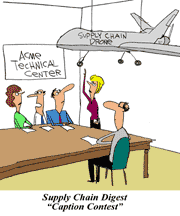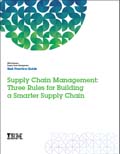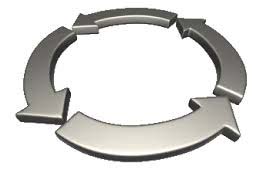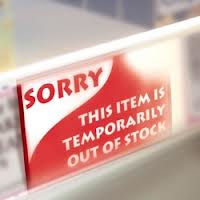 |
April 18, 2013 - Supply Chain Newsletter |
 |
| FEATURED SPONSOR: VOCOLLECT |
 |
Download the Vocollect Voice iPad® App for an In-Depth Look at how Vocollect can Help Deliver better Operating Results. |
 |
|
|||||||||||||||||||||||||||||||||||||||||||||||||
A Unified Theory of Out-of-Stocks?
|
||||||||||||||||||||||||||||||||||||||||||||||||||
| GILMORE SAYS: |
"So, mighty Walmart's supply chain is mightily challenged with OOS - no wonder the rest of us are too." WHAT DO YOU SAY? |
E-commerce has added a wrinkle to the retail OOS challenge, as now the issue isn't just products not being on the store shelf, but now potentially "not in stock" at the e-store as well. An OOS there likely has an even bigger impact in terms of lost sales than it does at brick and mortar retail.
I remember the Gilmore family in the 1990s might call up a cataloger such as Land's End or LL Bean and place an order for an item even though we were told that item was on back order and expected in at some certain date - who does that on-line? Or who today gets a rain check at a brick and mortar store for sale items that go out-of-stock, as our moms used to do? (Thanks to Richard Wilhjem of Compliance Networks for that latter observation).
Very few, of course - you go elsewhere, or don't buy at all. So the penalty for OOS rises.
But of course, out-of-stocks are not at all only a retail issue, it is a core supply chain and inventory challenge for virtually every company, though the problem mostly cast as "service levels" outside of retail.
As part of the research I did on OOS in the last few weeks, I found an article from 2010 in the International Review of Retail, Distribution, and Consumer Research from several European academics titled "Forty Years of Out-of-Stock Research - and the Shelves are Still Empty." That about says it all. The paper documents that despite study after study, and retail initiative after initiative, the needle has not really moved.
Case in point: as we reported in March, Walmart US CEO Bill Simon recently lamented to managers that stores sales were suffering because "We run out quickly and the new stuff doesn't come in."
It turns out that Walmart has been battling the problem since a least 2011, hired consultants, and placed a special executive to focus on the issue. But, Simon said, the problem lately has been "getting worse." (Walmart, we will note, didn't exactly deny these comments first reported by Bloomberg, but said they were taken out of context.)
So, mighty Walmart's supply chain is mightily challenged with OOS - no wonder the rest of us are too.
Here's why this issue is so complex: it is an equation that involves forecasting, "long tail" management, retail in-store execution, uncertain and/or difficult to calculate financial impacts, different impacts depending on product category, different impacts on retailers versus manufacturers, the Bullwhip Effect, the Perfect Order, vendor variability, store inventory accuracy, overstocks, collaboration, etc.
What have I left out?
It is a complex ecosystem for sure - yet I believe a "unified theory" (with a nod to Einstein) can be developed.
Here's a clue: In the videocast earlier this week, Joe Shamir, CEO of ToolsGroup, used a slide along these lines, which showed how less than 100% service levels at the vendor lead to more service degradation at downstream echelons all the way to the store shelf.
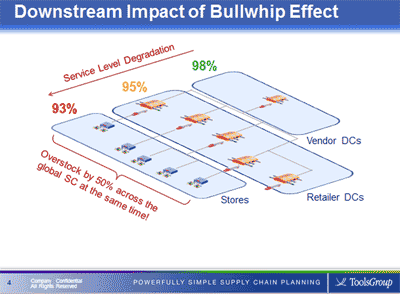
An important point from this graphic is that it isn't just an OOS problem - there is an equal and opposite reaction in terms of overstocks - too much inventory - either from the same issues that cause OOS or as a tactic to minimize the level of out-of-stocks.
In an upcoming videocast, MIT's Dr. David Simchi-Levi is going to among other excellent insights compare the differential impact on supplier fill rates and variability on required inventory levels. He will get to the core of "what is the purpose of inventory in the supply chain?" That is a question that more and more companies are really starting to ask, and it ties directly to OOS in every sector.
The first research on out-of-stocks is thought to be found in a 1968 article in Progressive Grocer magazine, and indeed much of the focus on the topic has been in the area of consumer packaged goods. That includes two famous studies, the last released in 2007, by Thomas Gruen of University of Colorado and Daniel Corsten of the IE Business School Madrid.
That latest Gruen study found out-of-stock rates in the CPG sector of 8.3%, slightly worse than the level found in 2002. The 2002 study also quantified consumer response to an OOS, as shown in the graphic below.
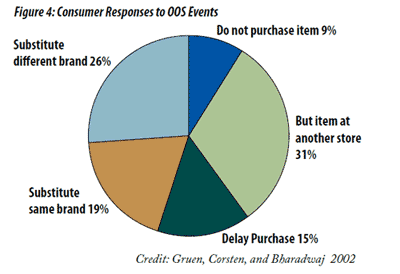
But of course, the response varies significantly by product/retailer type. If a can of soup is out of stock, a shopper might easily grab another flavor from the same vendor (good for the vendor and retailer), or the flavor they want from another brand (not good for the vendor, good for the retailer). If the size or color a shopper wants is missing at an apparel store, it is much more likely to result in no substitute purchase at all. As Shamir pointed out in this week's videocast, for long tail items, where demand is very intermittent, a stock out might result in no lost sales for some period, because there is no demand.
I am going to leave it there right now. But my research and listening to some of these experts convinces me that we can better tie the store side issues with the supply chain issues, and move the OOS ball further down the field in a more integrated and mathematical way. More soon.
Why haven't we done a better job improving out-of-stocks? Is there an opportunity to do a better job of connecting all the dots? Let us know your thoughts at the Feedback button (email) or section (web form) below.
![]()
| View Web/Printable Version of this Page |
|
|
|
YOUR FEEDBACK
We received a good number of emails from our First Thoughts piece on the Blurring of Supply Chain Planning and Execution.
That includes our Feedback of the Week from Ken McKeever of PLS Logistics Services, who actually wonders if we might not be a bit too far over our skis on this one. You'll find that letter, plus others supporting Gilmore's view below. More next week.
Feedback of the Week: On Blurring of Planning and Execution
At the risk of being misunderstood as a Luddite... I am reminded of an old joke that as you progress from a Bachelor's degree to Masters to PhD and beyond that you know more and more about less and less until you know absolutely everything about absolutely nothing. While our ability to detect, analyze and react to the ever increasing speed and granularity of the data is also increasing, the idea of blending planning and execution into one process sounds a bit dangerous. Concerns are now being expressed about people using technology to sort through all the flotsam and jetsam of data to get to that information they are most interested in - Netflix and Goodreads recommend your next movie or book based on previous favorites. News networks tailor their coverage to meet the preferences of a particular audience based on marketing feedback loops thus further concentrating the biases held by the viewer. In the opposite direction, Facebook and YouTube can propagate ideas at the speed of a smart phone whether that idea is freedom for the masses or gangnam-style. We don't yet fully understand the effects on society of these technological changes in the long-run, but we continue to run ever faster. Can a business be too reactive? What are the dangers of being too reactive to the marketplace? Consider the new language being created in the stock market where this technological Eden is most developed - algorithmic trading and machine ecology or more ominously, Flash Crash and Black Swan. How do we avoid the danger of becoming myopic as we are drawn into the ever accelerating current in the center of the data stream? We may experience the thrill of cleverly avoiding the individual rocks in our path as we become more skilled at digesting the ones and zeros before us. But how do we keep in mind that that same current may be heading us for a waterfall before our little stream empties into the larger river. We need a mechanism that forces us to pull off into an eddy now and then for a rest or refit, or to get up onto a hillside to see what is ahead. If "planning" is old-fashioned, we can come up with another word, but we still need oversight and a long-view. Ken McKeever
|
||
| More On Blurring of Planning and Execution: | ||
I couldn't agree more. I think the only limits on this are how flexible the networks really are/can be. Example: You may be able to change products in a plant on a dime, but if you need different raw material or packaging, who deals with that? In theory should be the supplier, but can they? Will their economics still work? The alternative, of course, is our old standby, just in case inventory for anything that takes awhile. Put another way, your network is only as flexible as your store of the longest lead time item in the process, whether that is raw material, work in process, or finished goods. Could lead to a whole new way of planning, evaluating, and operating networks. Very exciting times. Arnold Maltz |
||
| This trend is happening where ever companies have to compete on time. Take JIT concepts form the four walls to the Trading Network, lead time reductions in the execution windows that maintain service levels but reduce inventory make for a competitive advantage. Michael Schmitt
|
||
| I agree with you. Planning and Execution are, have been, and must blur.
Some years back, and not that many as you know, these could be different worlds. Hopefully marketing and sales had a direct link to the process (S&OP), but that is not always true even now. As consumers drive us toward a world where they demand near immediate gratification, upstream and downstream partners need to look beyond old paradigms. Planning and Execution must become a circular iterative set of events which should also include marketing, sales and distribution. Do we thing of picking, packing, shipping and the related outbound transportation to the customer as totally separate and only loosely related process steps? I hope not!!! Many organizations now plan these tasks end to end during order release to picking. They must in order to ensure that the carrier has assets available, they can pick up when the load(s) are ready so that shipments don't set on the dock taking up valuable space. And internally the shipper wants to maximize the efficiency of its operations such that the orders are packed, packed staged by drop point and made ready for loading just in time for the carrier to pick up. Would we expect less of the demand, planning, sourcing, component receiving, manufacturing (if necessary) and preparation for market? Steve Murray
|
||
SUPPLY CHAIN TRIVIA ANSWER
Q: There were two separate trade shows focused specifically on automatic identification technologies in the 1980s and 90s. What were they?
A: Scan Tech and ID Systems - the two shows combined sometime in the 1990s, then it became a broader Frontline show, then went away altogether in the early 2000s.
| © SupplyChainDigest™ 2003-2013. All Rights Reserved. SupplyChainDigest PO Box 714 Springboro, Ohio 45066 |
POWERED BY: XDIMENSION
|
